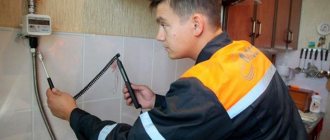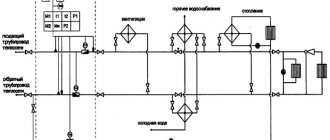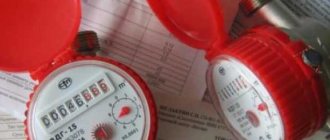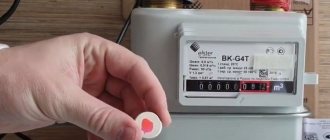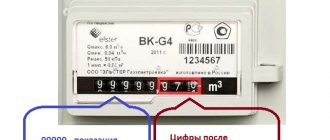Price:
From 6000 rub.
What's included in the price:
- Diagnosis of the problem; consultation
- Removal of old/installation of new heat meter
- Cleaning and trash removal
- Insurance services
- Agreement; guarantee on all work
It is advantageous to carry out heat metering in an apartment building together using one device (UKUT). Installation of a home heat meter by specialists is an economical option for residents.
Residents of apartment buildings, who are required to regularly pay utility bills, find it beneficial to take into account heat consumption using a joint meter. However, if organizational issues are resolved at meetings of apartment owners, then installing house meters is a job that is usually entrusted to professionals.
Who is required to install communal metering devices?
Their head should be installed so that they do not fall into the flow of hot air rising upward from the heating device. After calibration, the thermostatic head is able to maintain the required degree of supply necessary to maintain the desired temperature in the room. Many owners of apartments with rack-type heating systems are interested in how to solve the problem taking into account the consumed thermal energy, because installing metering devices on each radiator will cost a considerable amount of money.
In addition to significant initial costs, the consumer will have to periodically pay for their maintenance, verification and repairs in the event of a breakdown. Perhaps a special heat dispenser shown in the photo will help solve this problem.
Who should install communal heat meters?
On the one hand, she needs to pay monthly for the consumed thermal energy, because in the absence of payment, the heat supplier has the right to stop supplying it by closing the valves in the well. When severe frost sets in, turning off the heat in the house will certainly lead to serious consequences. But on the other hand, there are always defaulters among property owners.
Attention
Each management company solves problems with late payment differently. As practice has shown, there have been cases when heat debt was distributed among apartments whose residents regularly made monthly payments. In addition, the adopted law does not contain clear instructions regarding the actions of consumers in the event that the device fails.
There has been information in the media more than once that as a result of the failure of the metering device, consumers were billed for inflated amounts.
Save 20%
The Ministry of Economic Development is categorical: the abolition of the mandatory installation of individual heat energy meters is a step backwards. The department's position has been sent to the Ministry of Construction.
“We consider such initiatives to be unfounded and contrary to the consistent state policy in the field of energy saving and increasing energy efficiency,” the press service of the Ministry of Economic Development told Izvestia.
When apartments have individual meters, the house consumes up to 20% less heat.
Heating
Rational consumption will reduce the volume of fuel burned in boiler houses and power plants
Photo: RIA Novosti/Sergey Kuznetsov
“Savings are achieved due to the opportunity for residents to use thermal energy in the most rational way and at the same time save on paying for housing and communal services,” the ministry emphasized.
Strictly on instruments
The government is preparing a document that will allow you not to overpay for your neighbors when paying for heat.
Saving money and heating energy costs is not the only advantage. Rational consumption will reduce the volume of fuel burned in boiler houses and power plants and reduce emissions of pollutants and greenhouse gases into the environment, the Ministry of Energy added.
The law requires the installation of communal meters before July 1
As a rule, the condition of such houses is satisfactory: they do not require urgent major repairs of the water supply or electricity systems, and a considerable amount has already accumulated in the account of the high-rise building. This is what the residents decide to spend on installing meters. To do this, they need to convene a general meeting and vote.
Important
In this case, money is withdrawn from the “Current repairs” item. If there are insufficient funds, owners can raise funds to install a meter in addition to the main payments. Here you also need to hold a general meeting and vote on the target fee.
If the majority of owners agree to additional expenses, then even those who voted against will have to bear them. On behalf of the owners of the house, the HOA or management company will undertake the implementation of this decision.
Household heating meters: pros and cons
This is how the temperature difference over a certain time is determined. For this purpose, a special computer is provided in the meter. Calculation of thermal energy has an average error of 3-6%. The required data is supplied through flow and temperature sensors. One temperature sensor must be installed in the supply pipe of the system, and the second in the outgoing pipe. The computer analyzes the received data and displays the exact consumption figure on the screen.
Types of common house heat metering devices Different devices have different operating principles, installation and maintenance. It is best to provide the choice of the optimal option for the organization to install such equipment. Specialists will assess the condition of the house and, based on this, provide the required type of heat meter.
Types of heat meters
First, remember a simple truth: different devices, performing the same task, use completely different operating principles; their structure and installation method are also different.
The best option is to contact a company that does this work in your region. Its employees will advise you which type of meter will be most effective in your area, tell you what else you need to buy (a filter, for example) and indicate a list of papers that the company installing the equipment must provide.
There are four types of meters that are used by utilities today.
- Vortex.
- Electromagnetic.
- Ultrasonic.
- Tachometer.
Let's take a closer look at them.
Vortex device
They have a small obstacle behind which water vortices are formed. The more water passes through, the more often these vortices appear. The main advantage of such meters is that they can be installed on any type of wiring. The only condition is that there must be a straight pipe running before/after the device.
Another important advantage is the fact that equipment of this kind consumes very little energy. One battery can last at least five years. The devices “do not like” changes in pressure, as well as large objects located in the coolant, so a filter must be installed without fail. But even pieces of metal in water are not able to affect the performance. For this reason, management companies recommend vortex devices as the most reliable.
Finally, the third advantage is that the company can take indicators remotely thanks to radio communication. In the same way, they learn about malfunctions, which allows them to be quickly eliminated.
Electromagnetic device
This communal heating meter uses an electromagnetic field to measure volumes. When passing through the device, water creates a slight voltage due to the temperature difference. So the installation of such equipment should only be done by a professional; moreover, it will require regular maintenance. But if you do everything correctly, you will get extremely accurate indicators.
If you do not clean the meter on time, over time it will become covered with scale, which is why the results shown will be much higher than the real ones.
Note! Cleaning is very important! It happened that after repairs, the cost of thermal energy was halved!
In addition, the indicators can be affected by iron in the heat carrier, so the device can only be installed with high-quality water. And, again, it needs to be cleaned periodically.
Ultrasonic device
The principle of its operation is extremely simple: an electromagnetic pulse passes through the coolant. The stronger the pressure, the longer it takes for the signal to return. The devices work ideally in new houses with new pipelines without scale. But if there are foreign objects or even air bubbles in the water, then the device’s indicators will not be objective.
With a heat meter, it is necessary to purchase additional equipment that will allow you to control the liquid supply. In a professional environment, such meters are considered unreliable, as they often break down due to poor water quality.
Tachometer
An extremely simple device consisting of a mechanical rotor and a heat calculator. They are the cheapest meters, but at the same time they require the installation of a magnetic filter in front of them. Such a filter will protect not only the device, but also the entire heating system as a whole.
The main disadvantage is that the device cannot be used for:
- dirty water;
- too hard water.
Even the filter in such cases becomes clogged over time, causing the liquid pressure to weaken. This is precisely the reason that tachometer meters are found mainly in country houses.
The device operates on a battery (this is another advantage), which can last up to six years! And due to the fact that it does not contain electrical elements, the meter can be installed even under the most unfavorable conditions - for example, with high humidity, without fear that it will fail.
Who should pay for the installation of common house metering devices - from and to
Business lawyer Who should pay for the installation of common house metering devices - from and to Common house metering devices (CDMU) are quite important for monitoring the consumption of energy resources, gas and water by homeowners. Based on their testimony, authorized persons can verify the accuracy of information from their database. The legislation clearly regulates the mandatory procedure for installing meters and the rules for their operation, however, there are many misunderstandings around this practice on the part of ordinary citizens. In order to understand the question of who should pay for the installation of communal metering devices, and other nuances of the topic under consideration, we strongly advise you to pay attention to the material presented below.
Approximate calculation of the cost of installing a common house heat meter in Chelyabinsk
If we consider a standard five-story house, 4 entrances
, the approximate cost of a common house metering unit consists of the following components:
- design work: 15,000 - 30,000 rubles
depending on the requirements of the energy supply organization for the composition of design documentation - equipment: 80,000 - 120,000 rubles
or more, depending on what needs to be changed during installation. part of pipes, shut-off valves - installation work 20,000 - 60,000 rubles
All prices are very approximate and depend on many factors. But the final cost is always known before work begins and is clearly stated in the contract.
You need to understand that with monthly heating payments according to the standard of about 150,000 rubles and savings of 30%, the heat metering unit will pay for itself in 1-2 heating seasons and then will only bring “profit” to residents in the form of savings on utility bills!
The total cost of work will be from 115,000 to 210,000 rubles
Who will pay for the purchase and installation of a common house meter?
In this case, you will have to pay a fine: - for officials - in the amount of 5 to 10 thousand rubles - for persons carrying out entrepreneurial activities without forming a legal entity - from 10 to 15 thousand rubles - for legal entities - from 20 to 30 thousand rubles for OWNERS As we said above, after July 1, owners are required to pay for the metering device and the costs of the resource supplying organization for its installation. Refusal will result in legal action. In this case, the owner who loses the claim will also have to pay the company’s costs for legal services. Art. 13 clause 12 of the law on “Energy Saving”: “In case of refusal to pay expenses on a voluntary basis, a person who has not fulfilled the obligation to equip these facilities with meters for the energy resources used within the prescribed period must also pay the expenses incurred by these organizations in connection with the need for forced collection."
The cost of a common house appliance is shared among all residents.
- Everyone will now use heat more carefully. Residents will be more responsible about open entrance doors or a damaged window.
- The disadvantages include the high cost of the device. In this case, the device may fail, and the residents will again have to pay for its repair.
But the main disadvantage is the inability to save on heating the apartment due to lower consumption of thermal energy. The need to install a meter is determined at a general meeting of residents. After a written application to the relevant organization, the device is installed.To calculate the heat consumed, take the meter data and divide it by the area of the room. Of course, there are certain benefits from installing such meters. Otherwise, payment would have been made at inflated rates.
When installing a common house heating meter, the water in the house is shut off. Procedure for installing heat meters:
- Drafting the project;
- Obtaining permits;
- Installation of the device;
- Counter registration;
- It is necessary to check the functionality of the unit and draw up the necessary documentation.
The need to install a meter is determined at a meeting of residents. It is also necessary to raise funds for the installation of equipment. Then contact a qualified company. Subsequent verification and, if necessary, repairs are carried out by the same organization. The installation of heat meters is determined at a meeting of residents. House-wide meters calculate the amount of heat supplied to the house and distributed among residents based on the area of the apartment. The installation is carried out by special organizations, which the housing and communal services service will help you choose.
How is payment for thermal energy calculated?
Most high-rise buildings built during the Soviet Union have a vertical heating system. In such conditions, it is extremely unprofitable to install individual meters, since they will have to be installed on almost every radiator. The ideal option in this case is a communal heating meter, thanks to which you can at least somehow take into account expenses.
The payment procedure itself is simple and includes several steps.
- First you need to find out how much it will cost to heat each square meter in the house. To do this: the meter readings are multiplied by the current tariff, and the resulting figure should be divided by the total footage of the object.
- Then you need to determine what the share of your apartment is in the entire house. To do this: take the area of all premises and multiply it by the figure obtained after dividing all areas by the area of a particular apartment. This will give you the area of all the rooms that make up your apartment.
- Add to the area of the apartment everything else that is also yours. Multiply what you get by the cost of heating one square meter.
- Next, fill out a receipt where you must indicate the difference in indicators. Then, with the receipt, go to the nearest bank branch and pay the bill.
Note! Don't forget to indicate the name of the supplying organization on this receipt!
Detailed video guide
You may also be interested in an article about the design of an elevator heating unit, read more here
Who should install a communal heat meter in an apartment building?
If the management company and the HOA have not developed and communicated to residents proposals on measures to save energy and increase energy efficiency in apartment buildings, they face a fine: - for officials in the amount of 5 to 10 thousand rubles - for persons carrying out entrepreneurial activities without a legal education persons - from 10 thousand to 15 thousand rubles - for legal entities - from 20 to 30 thousand rubles. 2. If the resource supplying organizations did not come up with a proposal to management companies and homeowners associations to equip houses with metering devices, then they will also be punished in the form of a fine: - for officials in the amount of 20 to 30 thousand rubles - for legal entities - from 100 to 150 thousand rubles 3. If by July 1 the house is not equipped with common house metering devices for the management company and the HOA. If the management company or the HOA have never invited the owners at a general meeting to vote for the installation of meters, then they will have to answer to the law. But at the same time, it is impossible to regulate the heat supply, which is a significant disadvantage. The heat meter has a wide range of functionality. It allows you to determine the period of operation of devices, which is indicated on a specific metering unit. Also indicates the temperature of the coolant. But the main thing is to record the amount of heat energy consumed. The heat meter circuit includes:
- Thermal converters – temperature sensors;
- Calculator – calculates the amount of heat spent;
- Power supplies;
- Flow meter is a sensor for calculating volume.
Using a heat meter, you can accurately calculate the amount of heat consumed. A heat meter is used to record the received heat that comes with the coolant. The amount of energy used by the device per hour is determined, and the temperature of the liquid at the inlet and outlet and into the system is taken into account.
What influences the price range?
There are two decisive factors: manufacturer and type of equipment . Everything is clear with the manufacturer - the cost of the product is directly dependent on the technologies used by the plant. But the type of heat meters directly affects the performance characteristics, and therefore the cost of the product.
The equipment will differ in design features and data reading method . These differences directly affect the ability to install the device on a specific high-rise building.
Affects pricing and service life. Devices that will last from 2 to 4 years less, but the savings, in this case, are questionable. The design, installation and commissioning of the device are not free pleasures, so paying for them every 3-4 years is impractical. Considering that the average payback period for individual devices is at least three years, their purchase becomes economically unprofitable.

